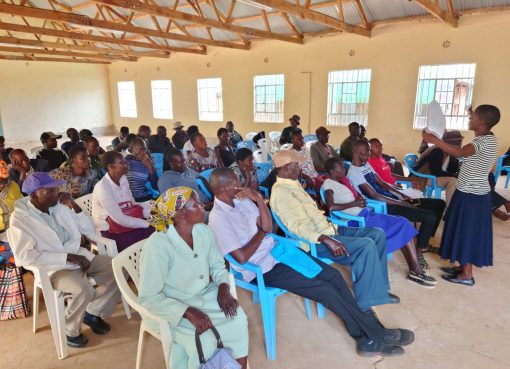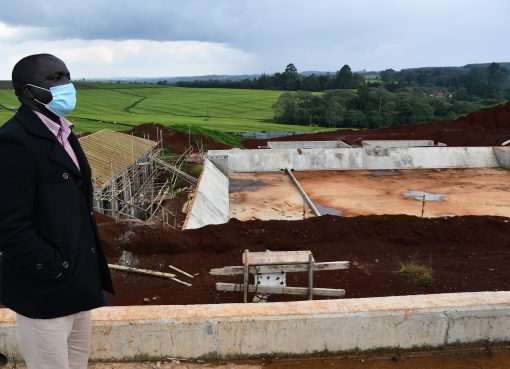Farmers in the ASAL areas that have been affected by locusts will soon benefit from Sh 4.3 billion World Bank fund to finance restoration of their livelihood.
Last month, Agriculture Ministry in partnership with the Food Authority Organisation (FAO) commissioned an impact assessment team under the leadership of Kenya Red Cross Society to evaluate the damage caused by desert locusts in the affected 16 counties.
A preliminary report reveals that more than one million hectares of crop and pasture land have been affected by the dangerous pest since last year, December.
Agriculture Cabinet Secretary Peter Munya had confirmed strategies to restore livelihood by various players targeting to support farmers and communities who have suffered economically following the desert locusts’ invasion in the country since December 2019.
Speaking during a forum organized by the Agriculture ministry, Agriculture Principal Secretary Hamadi Boga said that due to the intensified efforts by all the players, the number of counties affected have reduced from the initial 28 to the current four.
As at the moment the government in conjunction with other partners, FAO of the United Nations, World Bank, Desert Locust and Control Organisation (DLCO) and African Development Bank (AfDB) have managed to reduce the invasion to four counties –Turkana, Samburu, Marsabit and Isiolo.
“We are on top of the game and our hope is that in the next few months, we will have fully tamed the pest,” says Boga and added that the next phase targets livelihood rebuilding of the affected communities.
The PS explained that the Aerial and ground spray of swarms and hoppers has been ongoing in 17 counties where settling and breeding of swarms and hoppers had been taking place and this was undertaken following the support of National government and partners to the tune of Sh 2.4 billion.
Other resources that have been used to fight the pest, he noted, include vehicle mounted and motorized sprayers, hands held ULV sprayers, personal protective equipment (PPEs) and 700 knapsack sprayers.
The World Bank money provided under the three-year Emergency Locust Response Program will further be expended to finance surveillance control and long term sustainability.
On the restoration of livelihood, PS Boga said it will be done at County level while the national government will deal with the surveillance and also the long term capability of handling the locust menace.
Vinay Kumar a senior agriculture economist with World Bank said that the project expected to be implemented in the next three years targets to assists the residents restore their crop and pasture land and restock livestock.
The restoration programme is further designed to strengthen farmer producer organizations to facilitate access to inputs, services and output markets for sustainable restoration of their livelihoods.
“Livelihood rebuilding programme seeks to provide grants for input support through the micro projects to get crop and livestock production restored,” he said noting that the line of credit for Kenya is part of a larger regional emergency locust response project to respond to the threat posed by the desert locust outbreak and also to strengthen the country’s system for preparedness.
The Kenya component of the Emergency Locust Response Project will also provide immediate surveillance and locust management measures to halt the spread of the pests.
The project will prioritize coordination and early warning preparedness interventions by establishing and strengthening a Locust Control Unit (LCU) within the Plant Protection Services Division (PPSD) of the Ministry of Agriculture at the national level to prevent future outbreaks from spiraling out of control.
Vijay further said that the project will further strengthen the Ministry of Agriculture’s ongoing efforts in managing the locust attack. It will also enable technical support and assistance to the Ministry in enhancing their early warning and preparedness systems and to the counties in restoring livelihoods of the affected pastoralists and farmers.”
Hamisi Williams, Assistant Representative Programmes, FAO who also spoke during the webinar said the locust invasion is necessitated by changes in weather patterns.
“We have learnt a lot when fighting the pest, for example that locust invasion pattern is largely a weather issue and therefore accurate, continuous monitoring and prediction of weather pattern is key in migratory pest management,” he added.
Hamisi said that owing to the fact that the government faced challenges in terms of resources procurement leading to delay in attacking the locust from the beginning, there is need for agencies and Government to evaluate their internal processes for effectiveness.
The government, he added must agree to involve the private sector mainly the stockists to enhance availability of chemicals. He said in order to ensure sustained war against the locust, adequate training for local experts and young professionals for future engagement was key.
“There is need for domestication of desert locust control as part of curriculum in Kenyan institutions of higher learning,” he added.
The country has been under locust invasion since December 28, 2019 spreading to 28 Counties and the initial report confirms that that 984,478.9 hectares and 22,056 ha of pasture and crop land respectively have been destroyed by the migratory pest.
Presently, Turkana County is on red alert due to the expansive number of emerging hopper bands covering up to 296 sites, distributed in the sub counties (Turkana South- 64, Turkana East- 113, Loima- 32 and Turkana Central- 87) that are forming new swarms.
Governor Josephat Nanok, said that if left uncontrolled, the locusts will form new swarms that are expected to fly and therefore the need for intensified spraying of identified infested areas to minimize development of immature swarms which are most destructive, spread fast and are difficult to control.
“We have mobilized 20 field vehicles for NYS officers and any other mobile teams required, we are also planning to recruit within this week 430 youths to make sure the critical hot spots are identified and together with the 160 youth that FAO have trained, we can be able to curtail the situation,” Governor Nanok said.
Pastoralists from ASAL counties have been facing severe food security threat especially after the locusts invaded their vegetation and also because of closure of their livestock market due to Covid 19 pandemic.
A preliminary report compiled by an impact assessment team established last month by the ministry of agriculture, the locusts have destroyed more than one million hectares of crop and pasture land contributing to reduction of livestock and food levels.
By Wangari Ndirangu




